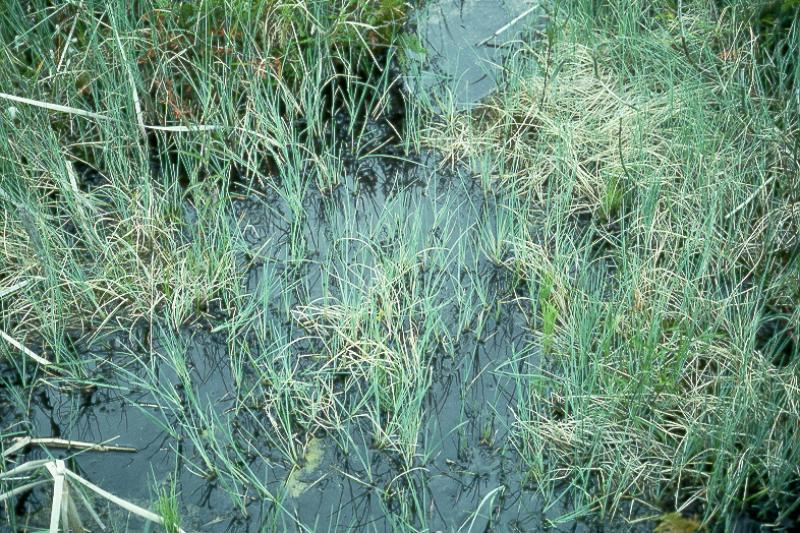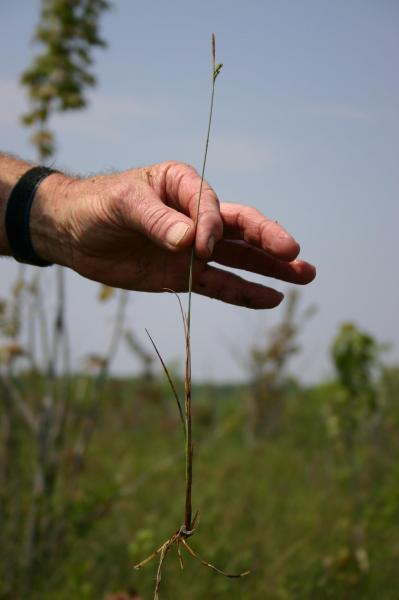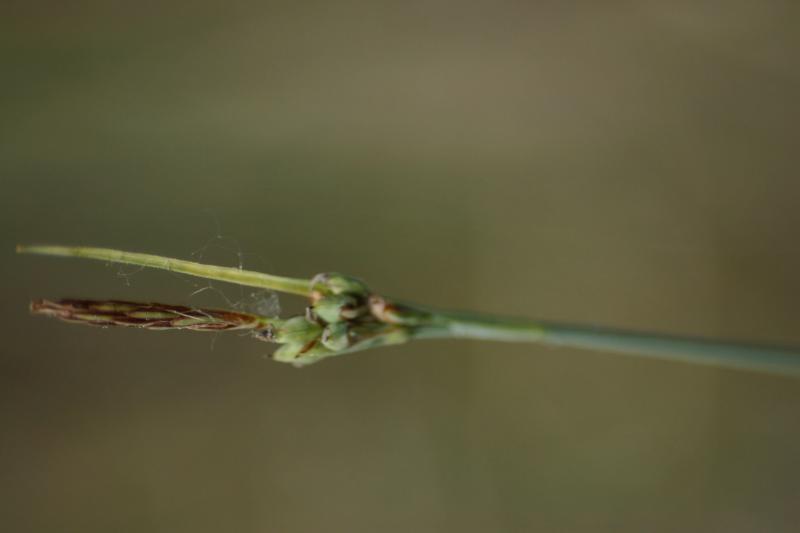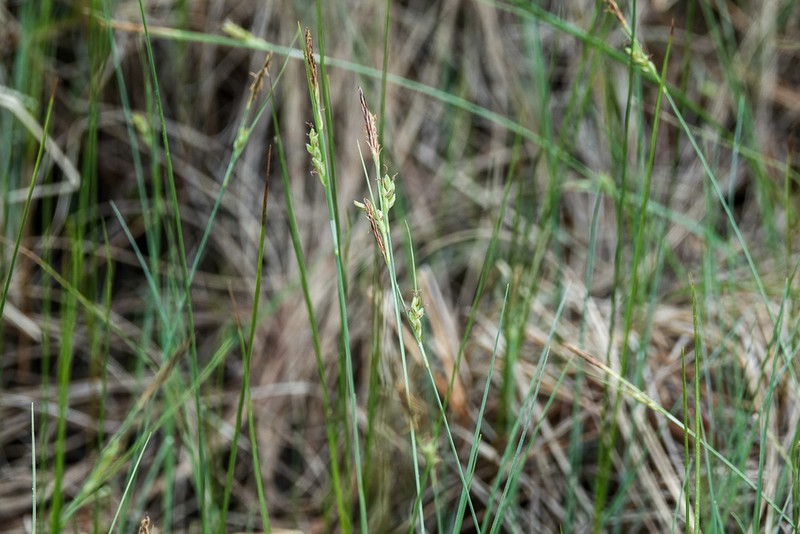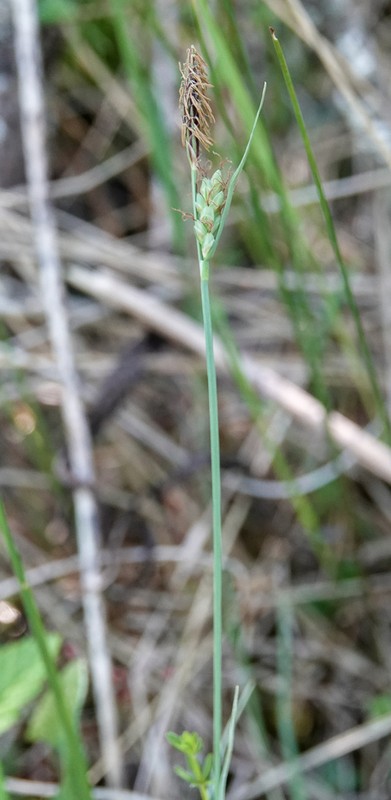Livid Sedge
Carex livida (Wahlenb.) Willd.
- Class
- Monocotyledoneae (Monocots)
- Family
- Cyperaceae (Sedge Family)
- State Protection
- Threatened
Listed as Threatened by New York State: likely to become Endangered in the foreseeable future. For animals, taking, importation, transportation, or possession is prohibited, except under license or permit. For plants, removal or damage without the consent of the landowner is prohibited.
- Federal Protection
- Not Listed
- State Conservation Status Rank
- S2
Imperiled in New York - Very vulnerable to disappearing from New York due to rarity or other factors; typically 6 to 20 populations or locations in New York, very few individuals, very restricted range, few remaining acres (or miles of stream), and/or steep declines.
- Global Conservation Status Rank
- G5
Secure globally - Common in the world; widespread and abundant (but may be rare in some parts of its range).
Summary
Did you know?
The specific epithet livida is a vague term that refers to the "effect of adding grey and black to the range of hues between blue and red," and was originally used to mean blue or leaden colored (Stearns 2004). This is probably in reference to the glaucous or light blue green color of Carex livida. So the common name, livid sedge, has nothing to do with this being an angry or furious plant.
State Ranking Justification
There are eight known populations and up to ten historical locations. This plant is found in open saturated areas of fens and bogs, a very specific and uncommon habitat type. Populations may be very local (i.e. common to a small area) but very rare across the entire habitat complex. A number of the known sites are within protected landscapes, but it still may be threatened by succession or hydrological changes.
Short-term Trends
There are six populations which are currently known to be extant. There is no data available on the trends at these populations but at least four of these populations have large numbers of plants present. Therefore, short term trends are not clear but may indicate that this species is currently stable in New York.
Long-term Trends
There are six or more populations that have not been seen in recent years. The locality information for most of these populations is poor and surveys have not been conducted to these sites. It is unknown if these populations are still extant. All of the six extant populations were first discovered within the past 20 years. They were probably overlooked in the past. Overall, long term trends are unclear.
Conservation and Management
Threats
Currently there are no threats to any population. Some potential threats include trampling by visitors, change in hydrology (including flooding by beavers), and development of areas adjacent to the wetland habitat where one population of C. livida occurs. There has also been minor filing on the edges of one of the wetlands where C. livida occurs. It is assumed that this filing has had little impact on the nearby C. livida population.
Conservation Strategies and Management Practices
Flooding by beavers should be prevented at populations that may be vulnerable to this activity.
Research Needs
Surveys should be conducted to all historical populations. Monitoring should be done at the one site that is being impacted by visitors trampling.
Habitat
Habitat
Carex livida occurs in peaty wetlands that are usually open and often somewhat mineral rich including rich to medium fens. It prefers open areas but can grow in openings in swamps. It also grows where there is standing water (New York Natural Heritage Program 2006). Boreal fens, calcareous floating mats (Rothrock and Reznicek 2002). Often circumneutral, wet soil, meadows, and fens (Haines and Vining 1998). Calcareous meadows, bogs, and depressions (Fernald 1970). Sphagnum bogs or wet places, usually in calcareous districts (Mackenzie 1931-1935).
Associated Ecological Communities
- Inland poor fen*
(guide)
A wetland fed by acidic water from springs and seeps. Plant remains in these fens do not decompose rapidly and thus the plants in these fens usually grow on older, undecomposed plant parts of mostly sphagnum mosses.
- Medium fen
(guide)
A wetland fed by water from springs and seeps. These waters are slightly acidic (pH values generally range from 4.5 to 6.5) and contain some dissolved minerals. Plant remains in these fens do not decompose rapidly and thus the plants in these fens usually grow on older, undecomposed plant parts of woody material, grasses, and mosses.
- Northern white cedar swamp*
(guide)
A swamp that occurs on organic soils in cool, poorly drained depressions in central and northern New York, and along lakes and streams in the northern half of the state. These swamps are often spring-fed with continually saturated soils. Soils are often rich in calcium. The characteristic tree is northern white cedar, which makes up more than 30% of the canopy cover.
- Rich graminoid fen*
(guide)
A wetland of mostly grasses usually fed by water from highly calcareous springs or seepage. These waters have high concentrations of minerals and high pH values, generally from 6.0 to 7.8. Plant remains do not decompose rapidly and these grasses usually grow on older, undecomposed plant parts.
- Rich sloping fen
(guide)
A small, gently sloping wetland that occurs in a shallow depression on a slope composed of calcareous glacial deposits. Sloping fens are fed by small springs or groundwater seepage. Like other rich fens, their water sources have high concentrations of minerals and high pH values, generally from 6.0 to 7.8. They often have water flowing at the surface in small channels or rivulets.
* probable association but not confirmed.
Associated Species
- Andromeda polifolia var. glaucophylla
- Carex chordorrhiza (creeping sedge)
- Carex lasiocarpa
- Cladium mariscoides (twig-rush)
- Larix laricina (tamarack)
- Myrica gale (sweet gale)
- Picea mariana (black spruce)
- Rhynchospora alba (white beak sedge)
- Thuja occidentalis (northern white cedar, arbor vitae)
- Trichophorum alpinum (lime-loving club sedge)
- Vaccinium macrocarpon (cranberry)
Range
New York State Distribution
Carex livida occurs mostly in the northern part of central New York with one population, at least formerly, in the Rochester area and one population in northeastern New York.
Global Distribution
Carex livida is a very widespread species occuring in South America, Central America (Panama), North America, Europe, and Asia. It is widely scattered throughout and uncommon or rare in parts of this range. In North America, it occurs from Alaska, Yukon, and British Columbia east to Quebec, Labrador, and New foundland south to New Jersey, New York, Indiana, Wisconsin, Minnesota, Colorado, and California (Rothrock and Reznicek 2002).
Identification Comments
General Description
Livid sedge is a grass-like perennial. It has long rhizomes and grows in patches. Leaves are a pale bluish-green color, thick, and are 1.5-6.5 mm wide. Stems are 15-55 mm tall and have 2-4 narrowly cylindrical flower/fruit clusters (spikes). The terminal spike is composed of staminate flowers or occasionally has a few female flowers at its apex. Other spikes are at the apex of secondary stems which branch off of the main stem. These spikes are composed of female flowers which mature into fruits (perigynia). Perigynia are pale bluish-green and 3-5 mm long (Mackenzie 1931-1935, Rothrock and Reznicek 2002).
Identifying Characteristics
Carex livida is long rhizomatous, colonial, and very glaucous. The leaves are very glaucous, deeply channeled, coriaceous, and 1.5-3.5(-6.5) mm wide. Culms are 15-55 cm tall and have 1-3 lateral pistillate spikes and 1 terminal staminate or rarely gynaecandrous spike. The proximal bract is shorter than to longer than the inflorescence. Pistillate scales are mostly pale brown to dark purple-brown. The perigynia are glaucous, fusiform, 3.0-4.8 mm long and lack or have a minute beak (Mackenzie 1931-1935, Rothrock and Reznicek 2002).
Best Life Stage for Proper Identification
Carex livida can be identified most of the growing season due to its very glaucous leaves. Still, identification is easier when the plants have immature to mature perigynia.
Similar Species
The very glaucous color of this plant distinguishes it from most other wetland plants. Carex aquatilis and C. tetanica can be somewhat glaucous at least part of the year but never as glaucous as C. livida. In addition, C. aquatilis is not closely related and has two stigmas and achenes biconvex in cross section. In comparison, C. livida has three stigmas and achenes trigonous in cross section.
Carex tetanica has a minute bent beak and herbaceous flat leaf blades. In comparison, C. livida has no or only a minute straight beak and coriaceous deeply channeled leaf blades.
Best Time to See
The plants start to produce immature perigynia in June and these mature and persist into August and sometimes a little later although, towards the end of this season the perigynia are shedding easily. With enough knowledge and practice C. livida can also be fairly easily identified when vegetative. Therefore, the best time to survey for this species is late June till early August.
- Vegetative
- Fruiting
The time of year you would expect to find Livid Sedge vegetative and fruiting in New York.
Livid Sedge Images
Taxonomy
Livid Sedge
Carex livida (Wahlenb.) Willd.
- Kingdom Plantae
- Phylum Anthophyta
- Class Monocotyledoneae
(Monocots)
- Order Cyperales
- Family Cyperaceae (Sedge Family)
- Order Cyperales
- Class Monocotyledoneae
(Monocots)
- Phylum Anthophyta
Additional Common Names
- Sedge
Synonyms
- Carex grayana Dewey [Type is the Utica, New York specimen collected by A. Gray.]
- Carex livida var. grayana (Dewey)Fern.
- Carex livida var. radicaulis Paine [Type locality is from Litchfield, Herkimer County, New York.]
Comments on the Classification
Carex livida is a widely distributed species. Populations from New York were once considered a distinct species or variety. If recognized at the varietal level the name would be C. livida var. radicaulis (Mackenzie 1931-1935, Voss 1972). Mitchell and Tucker (1997) claim that C. livida var. grayana (Dewey) Fern. is misapplied by NY authors when it is really a true synonym (Mackenzie 1931-1935). Carex livida is in section Paniceae (Rothrock and Reznicek 2002).
Additional Resources
Best Identification Reference
Rothrock, P.E. and A.A. Reznicek. 2002. Carex Linnaeus sect. Paniceae G. Don. Pages 426-431 in Flora of North America Editorial Committee (editors), Flora of North America, north of Mexico, Volume 23, Magnoliophyta: Commelinidae (in part): Cyperaceae. Oxford University Press, New York, NY, USA. 608pp + xxiv.
Other References
Fernald, M.L. 1950. Gray's manual of botany. 8th edition. D. Van Nostrand, New York. 1632 pp.
Gleason, Henry A. and A. Cronquist. 1991. Manual of Vascular Plants of Northeastern United States and Adjacent Canada. The New York Botanical Garden, Bronx, New York. 910 pp.
Holmgren, Noel. 1998. The Illustrated Companion to Gleason and Cronquist's Manual. Illustrations of the Vascular Plants of Northeastern United States and Adjacent Canada. The New York Botanical Garden, Bronx, New York.
Mackenzie, K.K. 1931-1935. Cariceae. North American Flora 18: 1-478.
Mitchell, Richard S. and Gordon C. Tucker. 1997. Revised Checklist of New York State Plants. Contributions to a Flora of New York State. Checklist IV. Bulletin No. 490. New York State Museum. Albany, NY. 400 pp.
New York Natural Heritage Program. 2010. Biotics database. New York Natural Heritage Program. New York State Department of Environmental Conservation. Albany, NY.
New York Natural Heritage Program. 2024. New York Natural Heritage Program Databases. Albany, NY.
Reschke, Carol. 1990. Ecological communities of New York State. New York Natural Heritage Program, New York State Department of Environmental Conservation. Latham, NY. 96 pp. plus xi.
Stearn, W. T. 2004. Botanical Latin. Fourth edition. Timber Press, Portland, Oregon. 546 pp +xiv.
Voss, E.G. 1972. Michigan Flora, Part I. Gymnosperms and Monocots. Cranbrook Institute of Science Bulletin 55 and the University of Michigan Herbarium. Ann Arbor. 488 pp.
Weldy, T. and D. Werier. 2010. New York flora atlas. [S.M. Landry, K.N. Campbell, and L.D. Mabe (original application development), Florida Center for Community Design and Research http://www.fccdr.usf.edu/. University of South Florida http://www.usf.edu/]. New York Flora Association http://newyork.plantatlas.usf.edu/, Albany, New York
Links
About This Guide
Information for this guide was last updated on: November 4, 2022
Please cite this page as:
New York Natural Heritage Program. 2024.
Online Conservation Guide for
Carex livida.
Available from: https://guides.nynhp.org/livid-sedge/.
Accessed July 27, 2024.
